Yves GARY Hits: 3603
Category: 1895 : CHALLENGE N°9
 OUTSAILED THE ENGLISHMAN AT EVERY POINT
OUTSAILED THE ENGLISHMAN AT EVERY POINT September 07, 1895 - The committee boat, the tug Luckenback, ...
September 07, 1895 - The committee boat, the tug Luckenback, ...
... anchored off Seabright about 11:45, and at once signaled the course, which was east by south. The wind was very light, and there seemed to be little prospect of it freshening at all during the day. Heavy banks of cloud hung around the horizon, and the smartest old salts on any of the yachts or excursion boats could not scent an extra breath of wind in any of them.
The tug Edgar Luckenback, with Super-Intendent Neils Olsen on board, was sent off to log the course, and then everything was ready for the races. The two yachts, the Defender and the Valkyrie, had taken tows from the Sandy Hook Lightship, and as they approached the committee boat they past off and proceeded under their own sails.
The Defender was the first to arrive at the starting line, and some took it as an omen of good luck. She sailed around under mainsail, clubtopsail, jib, and staysail. The Valkyrie had her staysail in stops ready to break out, when it should be needed.
According to the arrangements between Lord Dunraven and the Cup Committee, when the starting point was changed or the time for the start postponed a preliminary signal was to be given fifteen minutes before the preparatory signal. This was done in order that the yachts should have ample opportunity to get in readiness for the start.
The preliminary signal was given at 11:55, and the yachts began a series of pretty maneuverings that lasted twenty-five minutes and which were greatly admired by the crowd of excursionists on the big steamers that had gone out to the race. The excursion steamers, tugs, and yachts had formed a semicircle round the line, with Commodore Bergen's fleet of patrol boats on the inside, keeping all the others back as far as they could, so that the racers should have ample opportunity to maneuver.
 When the preliminary signal was given, both yachts were to the eastward of the line, on the starboard tack, heading to the north, with the Defender in the lead. The crew was just as flat as those on the Defender. The beautitul sails of the Valkyrie set to perfection, and they, too, were drawing, and for a while it seemed as though they were doing better work than those of the American boat. Capt. Haff had gained the weather position at the start, and he intended to keep it. He pinched his boat right up in the wind, perhaps a little too much in his anxiety to keep to windward, while Capt. Cranfield gave the Valkyrie a good full, and the English boat, to everyone’s dismay, gradually drew clear of the Defender, and in a few minutes there was daylight between the two boats. Capt. Haff was clearly outpointing the English boat with the Defender, but the Valkyrie was footing so much faster that what little the Defender was gaining to Windward was being more than offset by the Valkyrie in going faster through the water.
When the preliminary signal was given, both yachts were to the eastward of the line, on the starboard tack, heading to the north, with the Defender in the lead. The crew was just as flat as those on the Defender. The beautitul sails of the Valkyrie set to perfection, and they, too, were drawing, and for a while it seemed as though they were doing better work than those of the American boat. Capt. Haff had gained the weather position at the start, and he intended to keep it. He pinched his boat right up in the wind, perhaps a little too much in his anxiety to keep to windward, while Capt. Cranfield gave the Valkyrie a good full, and the English boat, to everyone’s dismay, gradually drew clear of the Defender, and in a few minutes there was daylight between the two boats. Capt. Haff was clearly outpointing the English boat with the Defender, but the Valkyrie was footing so much faster that what little the Defender was gaining to Windward was being more than offset by the Valkyrie in going faster through the water.
The sea on this tack was right on the yachts’ quarter, and seemed to bother them very little. Occasionally a big wave would roll under one or the other of them and spill the wind out of their sails, but it did not seem to retard their progress through the water at all.
The Valkyrie, on account of her greater beam, made more fuss in the water than the Defender. There was quite a wave under her bow, while there was comparatively little under that of the Defender. At the end of fifteen minutes’ sailing the Valkyrie appeared to be about 200 yards ahead, but considerably to leeward of the Defender, not so much, though, as she was ahead. They were making good headway in the light breeze, and the outlook for the race being finished in time was exceedingly good. They were heading to the northeast, and the big fleet of excursionists nearly all kept astern or well to leeward of them. One or two persisted in working around to windward of the racers and gave the Captains of the patrol boats a chance to exercise their persuasive powers in trying to induce them to withdraw.
 The starboard tack was held for nearly twenty minutes, and at 12:39:30 the Defender tacked to port. She was followed fifteen seconds later by the Valkyrie. Both yachts spun around like tops.
The starboard tack was held for nearly twenty minutes, and at 12:39:30 the Defender tacked to port. She was followed fifteen seconds later by the Valkyrie. Both yachts spun around like tops.
The crews handled the sails like lightning, and had them flat on the other tack before the yachts had got round. On this tack the yachts were heading to the southward. The seas were ahead, and they seemed to bother the Valkyrie much more than they did the Defender. They caught her just as they did the Vigilant, right under her bow, causing her to jump and shake the wind out of her sails. On this tack the Valkyrie had the weather position. The Defender at once began to improve her position, and footed much faster than the English boat.
So far, while the race was close, and it was nip and tuck between the two yachts, it was uninteresting, there not being wind enough to give the yachts life. A breeze was wanted, and wanted badly, in order to give the racers a fair test. Capt. Haff was giving the Defender a little freer wind than he had at the start, and the American boat was doing much better.
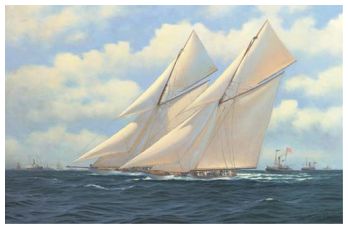 At 1:11:45 the Valkyrie tacked to starboard, and she was followed at once by the Defender. This placed the Valkyrie considerably in the lead, but the Defender had worked up so that she was a little to windward of the English boat.
At 1:11:45 the Valkyrie tacked to starboard, and she was followed at once by the Defender. This placed the Valkyrie considerably in the lead, but the Defender had worked up so that she was a little to windward of the English boat.
It began to look as though the Valkyrie was going to win, and many gave up the race then, while those who had been shouting for the Valkyrie became very enthusiasm over the performance so far. One old Yankee skipper, who has seen races sailed since the Cambria came over here, had not taken his eyes off the yachts since they crossed the line, and when they went on this last tack quietly remarked: “I guess she can carry that pewter home."
It was early in the race. The yachts had not sailed five miles, and lots might happen in the other twenty-five. Lots did happen, too, and the Valkyrie was only destined to hold the lead for a short while longer. Capt. Cranfield was letting the English boat toot along with a good full, and she was gradually outfooting the American boat, but Capt. Haff had his eye out to windward all the time, and was pinching and pushing the Defender inch by inch out into the wind, and every inch out this way told more than two the way the Valkyrie was going.
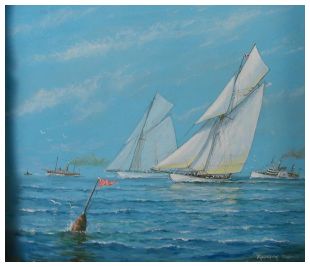 After an hour's sailing there seemed to be about a quarter of a mile of daylight between the two yachts, but the Defender was well to windward of the Valkyrie. It is possible that the Valkyrie could have crossed the Defender’s bow at this time, and why Capt. Cranfield did not try to do so then was wondered at by many yachtsmen who watched the race.
After an hour's sailing there seemed to be about a quarter of a mile of daylight between the two yachts, but the Defender was well to windward of the Valkyrie. It is possible that the Valkyrie could have crossed the Defender’s bow at this time, and why Capt. Cranfield did not try to do so then was wondered at by many yachtsmen who watched the race.
The yachts had got over the bar and out of shoal water, and there was not nearly so much sea; just the steady roll that comes in from the Atlantic after two or three days’ wind from the eastward. The Valkyrie would plunge her bow down on to some wave and send the spray flying on each side of her, while the Defender seeming to rise on each billow and almost jump on to the next one, landing easily on top of the water and making very little fuss.
The wind as they got further outside seemed to be a little stronger, and both yachts began to foot a little faster. At 1:47:30 the Valkyrie tacked to port, and the two boats were for the first time approaching each other on opposite tacks. The excitement as the two drew together was intense. The Englishman's partisans and there were many of them out there, were shouting for the Valkyrie, and for a while it looked as though the English heat would get the better of the Defender. The Americans watched the contest in silence. It had seemed so far that the Valkyrie was in the lead, and they hardly expected that the Defender would cross the Valkyrie’s bow.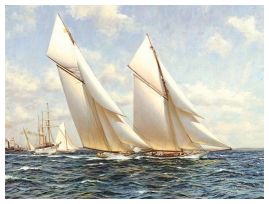
If the Valkyrie crossed the Defender’s bow she would tack at once on her weather, and the race, so far as a contest was concerned, would be practically over. If, on the other hand, the Defender could cross the Valkyrie it would show conclusively that the American boat was in the lead, and those who had been anxious about the safety of the America's Cup would breathe easier. The Valkyrie only held this tack for a minute, but to those who were watching it seemed like an hour. At 1:48:30 the Valkyrie tacked to starboard. She had been unable to cross the Defender, and the Defender having the right of way, had forced her about.
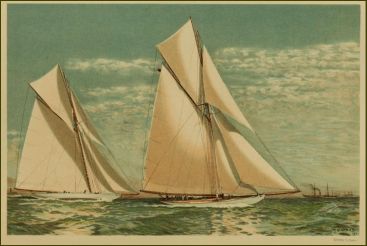 The Englishmen looked glum. The Americans cheered and all the steam vessels around the yachts blew their whistles. From then on to the end of the contest the spirits of the thousands who had gone down to see the first race for the America's Cup revived, and every vessel outside except, possibly, the English yacht Valhalla, had a jolly party on board. At 1:49:10 the Defender tacked to port. She was standing to the southward.
The Englishmen looked glum. The Americans cheered and all the steam vessels around the yachts blew their whistles. From then on to the end of the contest the spirits of the thousands who had gone down to see the first race for the America's Cup revived, and every vessel outside except, possibly, the English yacht Valhalla, had a jolly party on board. At 1:49:10 the Defender tacked to port. She was standing to the southward.
It was raining down in the south, and it looked as though a breath of wind might come in from that quarter, and if so, she would catch the benefit of it, and probably get a good lift on the Valkyrie. Capt. Cranfield put the Valkyrie on the port tack at 1:52:45, and fifteen seconds later the Defender tacked to starboard, and the two were drawing together again.
The wind had hauled just a little more to the southward, and the Defender had caught a little slant that sent her ahead, so that at 1:46:45 she crossed the Valkyrie's bow, and as she did so, Capt. Haff put the wheel hard over, and the Yankee yacht spun round like a top on the weather bow of the Englishman. Again the whistles from the excursion steamers, tugs, and yachts tooted out their appreciation of the move.
 It did not suit Capt. Cranfield a bit, for the Defender had hardly got full on the port tack before the Valkyrie tacked to starboard and headed again toward the north. The Defender held on the port tack until 1:59:20, and she, too, tacked, standing to the northward. The yachts had been sailing about one hour and forty minutes. More than half of the windward journey had been made, and the two boats were practically in the same position as they were when they crossed the starting line. It had been a remarkably close contest, so far, and it was still anybody’s race. The mark boat could be distinctly seen in the distance, and in order to fetch it both made a long tack to starboard.
It did not suit Capt. Cranfield a bit, for the Defender had hardly got full on the port tack before the Valkyrie tacked to starboard and headed again toward the north. The Defender held on the port tack until 1:59:20, and she, too, tacked, standing to the northward. The yachts had been sailing about one hour and forty minutes. More than half of the windward journey had been made, and the two boats were practically in the same position as they were when they crossed the starting line. It had been a remarkably close contest, so far, and it was still anybody’s race. The mark boat could be distinctly seen in the distance, and in order to fetch it both made a long tack to starboard.
The wind hauled further to the southward, which gave the Defender a little more advantage over the Englishman. The Defender was outpointing and outfooting the Valkyrie now, and it looked almost as though those on board the American yacht had been only fooling, and that, with he mark boat in sight, they made up their minds that it was time to take the lead. Really, in the earlier part of the race, Capt. Haff had been pinching the Defender in order to get her well to windward of the Valkyrie, and, having gained the position that he was after, he was giving her a little more full and letting her foot fast.
The situation was changed, and the Valkyrie, now being the leeward boat, was being pinched in order, if possible, to work her up to the Defender. Capt. Cranfield did not have Capt. Haff’s luck, for every minute the American boat was lengthening the distance between the two.
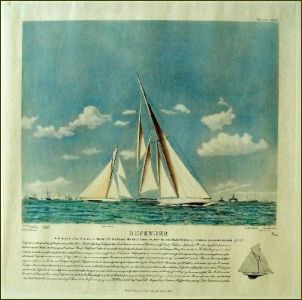 The wind seemed to be a trifle better than it had been so far, but it was puffy. It would blow on the yachts for a m mute and then slack up, and it was hauling all the time further to the south. At about 3 o'clock the Defender drew clear of the Valkyrie, and after that it was only a question of how much she would beat her to the outer mark, which they were then rapidly approaching. The Defender seemed to be getting a little better breeze than the Valkyrie, and she heeled just a little as she sped through the water.
The wind seemed to be a trifle better than it had been so far, but it was puffy. It would blow on the yachts for a m mute and then slack up, and it was hauling all the time further to the south. At about 3 o'clock the Defender drew clear of the Valkyrie, and after that it was only a question of how much she would beat her to the outer mark, which they were then rapidly approaching. The Defender seemed to be getting a little better breeze than the Valkyrie, and she heeled just a little as she sped through the water.
At 3:25 the Defender tacked to port and stood for the mark. Valkyrie followed at once, and it was seen that the Defender was at least a third of a mile ahead of the English boat. She had slightly over stood the mark, as the Valkyrie, which was considerably to leeward of her, was able to fetch without any difficulty. The Defender was given a good rap full, and she just romped down on to the stakeboat. She still continued to draw ahead of the English boat, and evidently, thinking of the reports of the Valkyrie’s marvelous speed when off the wind, Capt. Haff wanted to get as far ahead as possible before starting on the homeward journey. At 3:30 the jib topsail on the Defender was taken in. She was then some distance from the mark and it seemed as though this sail might have been carried some minutes longer.
The Deer Island sailors moved like lightning. The order was no sooner given than the half dozen whose duty it was to tend to the jibtopsail were out on the end of the bowsprit, the halyard was slackened, and the sail ran down the stay, being neatly caught by the men and passed inboard. Then the balloon jibtopsail was run out and quickly run up in stops, so that as the yacht approached the mark everything was in readiness for the homeward run, and not a second’s time would be lost in getting the big balloon drawing.
At 3:36:29 the Defender passed the outer stakeboat. As she did so her sheet was eased off and her boom swung over the starboard quarter. The balloon jib topsail was broken out, and, filling at once, the yacht seemed to jump forward and speed toward the home mark.
The Valkyrie carried her jibtopsail until 3:35:00, and then half a dozen of the English crew went out on the bowsprit, just like those on the Defender; the sail was run down, the bigger one bent on and hoisted, and all was ready to break out as soon as she turned. She passed the mark at 3:39:52, and as she did so the balloon was broken out, and the main sheet eased off, and she, too, was on the homeward journey. On the fifteen-mile beat to windward the Defender had taken 3:15:39, the Valkyrie had taken 3:19:06, so that the Defender had beaten the Valkyrie 3:21, and this beating was all done in the last hour and a half of sailing.
Both yachts were considerably interfered with by the big excursion steamers as they rounded the outer mark. The steamers had formed a semi-circle around the stake, just as they did around the starting line, but they crowded inconveniently near, and as a result ,the wind must have been considerably broken. The two worst boats to bother the racers were the City of Lowell and the Richard Peck.  They were well to windward of the stake, and being big boats, caused much more trouble than any of the smaller ones. The Peck got out of the way after a while, but the City of Lowell persisted in following, the racers up, keeping on their port hand, or just in the direction that the wind was coming. It was several minutes after rounding before the Valkyrie’s balloon jib topsail drew at all properly, and it is probable that the fleet of steamers around the mark was mainly the cause of this trouble.
They were well to windward of the stake, and being big boats, caused much more trouble than any of the smaller ones. The Peck got out of the way after a while, but the City of Lowell persisted in following, the racers up, keeping on their port hand, or just in the direction that the wind was coming. It was several minutes after rounding before the Valkyrie’s balloon jib topsail drew at all properly, and it is probable that the fleet of steamers around the mark was mainly the cause of this trouble.
The course yesterday was to have been fifteen miles to windward and return, but the wind hauling. as they neared the outer mark, round to the southeast, made it a reach back home instead of a run. This was a disappointment to many. They wanted to see the Valkyrie with her spinnaker set sailing before the wind. Reports of her great speed when off the wind had been received over here, and there were many who thought she would be able to make up the difference between the two boats at the outer mark. She may be speedy off the wind or reaching when there is a good breeze, but yesterday the Defender ran right away from her.
 After getting well started on the homeward journey the staysail and jib on each yacht were taken in, and then the crew on each boat gathered further aft, and settled down to see what the yachts would do. The excursion steamers formed two lines, and the racers sailed down the lane between the two. The patrol boats were kept busy trying to keep the excursion steamers and tugs back.
After getting well started on the homeward journey the staysail and jib on each yacht were taken in, and then the crew on each boat gathered further aft, and settled down to see what the yachts would do. The excursion steamers formed two lines, and the racers sailed down the lane between the two. The patrol boats were kept busy trying to keep the excursion steamers and tugs back.
After sailing about fifteen minutes the Defender set her staysail, and she carried it at least twenty minutes before those on the Valkyrie discovered what had been done. The sail drew well, too, and must have materially improved the Defender’s speed. Her balloon jibtopsail set perfectly, and Capt. Terry, who attends to the head sails, had it trimmed just right.
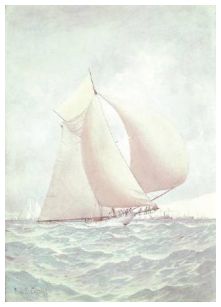 The balloon topsail is a beautiful drawing sail when properly handled, and the difference between the way the two sails were handled on the yachts was marked. The Defender’s was given plenty of sheet, while the Valkyrie’s was trimmed in so that it did not seem to hold the wind at all. The Defender’s blew out as stiff as a board, and there was hardly a wrinkle in it during the whole of the fifteen miles to the home mark.
The balloon topsail is a beautiful drawing sail when properly handled, and the difference between the way the two sails were handled on the yachts was marked. The Defender’s was given plenty of sheet, while the Valkyrie’s was trimmed in so that it did not seem to hold the wind at all. The Defender’s blew out as stiff as a board, and there was hardly a wrinkle in it during the whole of the fifteen miles to the home mark.
The Valkyrie seemed to spill the wind all the way along. The balloon jib topsail is a sail that the Englishmen use comparatively little. They have an idea that it doesn't pay to shift from the smaller sails to the large one. American yachtsmen are great believers in this sail, and will carry it whenever they get a chance. They know how to handle it well, too.
The Defender continued to draw away from the Valkyrie, and when half the journey home had been completed, she had gained at least two minutes more, and bets were freely made that she would beat the English boat by ten minutes. She went through the water beautifully, and all that was needed to make the picture a perfect one was a little sunshine. It had been gloomy all day long, and about 4:30 it began to rain. The rain, however, could not dampen the enthusiasm of those who had gone out hoping that the Defender would win, and they started to cheer the Bristol boat long before the finishing line was reached. Pilot Boat No. 3 was passed on the journey in, and she ran out of her course to draw near to the Defender and give her a salute of one gun. Then she ran down to the Valkyrie and gave the Englishman a gun.
 As the yachts drew near to the finishing line the excursion steamers went forward to get a prominent position to see them as they crossed. There was considerable crowding around the two stakeboats, but the line was kept comparatively clear. The Defender kept on her victorious course, and just as she approached the finishing line the plucky owner of the Valkyrie. American yachtsmen, as a rule, don’t want to see the America's Cup go to England, but if it is to be lost there is no one they would prefer to have win it more than Lord Dunraven. He has made a plucky fight twice for the cup, and it seems almost too bad that he can’t get nearer to the American yacht than he does.
As the yachts drew near to the finishing line the excursion steamers went forward to get a prominent position to see them as they crossed. There was considerable crowding around the two stakeboats, but the line was kept comparatively clear. The Defender kept on her victorious course, and just as she approached the finishing line the plucky owner of the Valkyrie. American yachtsmen, as a rule, don’t want to see the America's Cup go to England, but if it is to be lost there is no one they would prefer to have win it more than Lord Dunraven. He has made a plucky fight twice for the cup, and it seems almost too bad that he can’t get nearer to the American yacht than he does.
Yesterday's race, however, was only the first of the series, and it is possible that he may win one or more or the races yet to be sailed. In this country it has generally been believed that the Valkyrie is best in light weather, weather like that which prevailed yesterday. Lord Dunraven, last Wednesday, said that he didn't known his boat was a light weather boat until he got to this country, and that he always believed, and believes yet, that the Valkyrie is best in a good breeze, and that she can carry her sail in any kind of a breeze that blows.
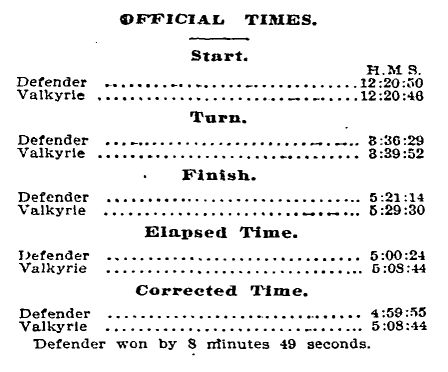
If this is the case, and there is good weather next week, with plenty of wind, the chances are that some rattling good yachting contests will be seen for the cup yet. On the run home the Defender took 1 hour 44 minutes and 45 seconds. The Valkyrie's time was 1 hour 49 minutes and 38 seconds, so that the Valkyrie was beaten by the Defender 4 minutes and 53 seconds on the fifteen miles broad reach. This was even more of a surprise than the Defender's victory to windward.
Over the entire course, the Defender's elapsed time was 5 hours and 24 seconds; the Valkyrie’s elapsed time was 5 hours 8 minutes and 44 seconds, so that the Defender beat the Valkyrie 8 minutes and 26 seconds, and allowing for the 29 seconds which the Valkyrie has to give the Defender, the latter won by 8 minutes and 49 seconds.
After finishing the race both yachts were towed to their anchorages for the night. The next race will be on Tuesday. The course will be an equilateral triangle of ten miles to each leg, the first leg, if possible, being to windward. It is possible that some changes will be made in the Valkyrie‘s trim before that race. Yesterday's race may satisfy those who are in charge of her that her speed can be improved by altering her ballast and trim, or by changing her spars and rig. If this is done, the yacht will have to go to Erie Basin again to be remeasured. Yachtsmen want to see a good clubtopsail breeze on Tuesday, and on Thursday a hard blow, so that the yachts can only carry working topsails. If the weather favors them like this, there will be three good tests, all under different conditions.
